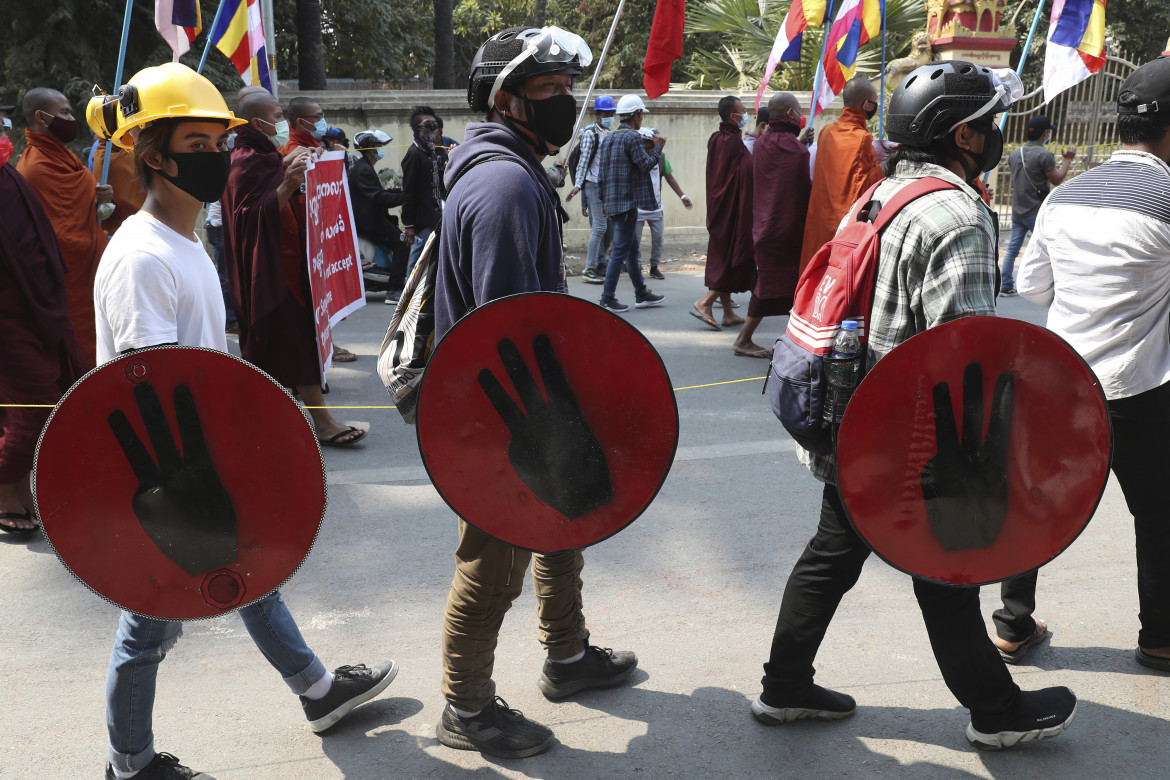Analysis
Myanmar protesters stage a 10-day general strike in the face of military violence
The junta responded with a 24-hour curfew to prevent street protests. Women have taken a central role in organizing against the coup.

A 10-day general strike should block Myanmar again tomorrow. And an extended curfew of 24 hours a day will be imposed by the junta from Monday for several weeks, precisely to prevent the protest from taking to the streets again.
This is the news coming from a country overwhelmed on Feb. 1 by a military coup, totally isolated on the international level, and one of the largest movements of peaceful civil disobedience in recent history. And it seems to be the modern evolution of the Indian movement of the 1940s, which lessened the power and the weight of the British crown.
The signs of what promises to be a very difficult week come from the assault on the few shops open to make provisions and from the columns of military vehicles arriving in Yangon for an unprecedented deployment of soldiers.
The feeling, our sources in Myanmar say, is that the clandestine committee of the new parliament elected on Nov. 8, which is in effect Aung San Suu Kyi’s League for Democracy, has acquired more and more legitimacy and consensus, developing an increasingly recognized leadership capacity. They are asking for the end of the junta and the release of prisoners, for the appointment of shadow ministers, the invitation to temporarily stop paying taxes and a firm stance against the establishment of the 2008 constitution (wanted by the military and which gives them the legal basis — even if contested in the non-compliant application of the dictation — to the coup).
Their demands, which hope for a federal state, not only challenges the charter but seems to respond to those political and armed groups of the regional peripheries that have never recognized it. They are racing toward an ever widening consensus against a ruling power that is based only on terror and the use of weapons, which were also yesterday’s protagonists of the day.
In fact, people returned to the streets on Saturday challenging bullets, fire hydrants, tear gas and barrels while at a closed-door Security Council meeting in New York, UN special envoy Christine Schraner Burgener addressed the 15 members with these words: “Can we allow the Burmese military to get away with it?”
But if international diplomacy, slowed down by Russia and China and by a discussion where controversy over sanctions collide, fails to subvert the coup, the protest movement continues undaunted, resorting to every possible stratagem to stop the military.
For example by throwing the images of General Min Aung Hlaing (junta chief) on the ground and then forcing the soldiers to trample them, a gesture that means hitting a specific person with the most impure part of the body: the sole of the foot. They have also draped Burmese skirts across the streets. If a man passes under them, according to tradition, he loses his masculine potency.
The gestures speak of a revolutionary creativity in which women are protagonists. A quarter of those arrested (over 1,700) are women and have allegedly been subjected to physical and verbal violence, in a shared agony with dozens of victims and hundreds of injured.
Meanwhile, more and more monks are arriving alongside women, men and young people (in the procession this weekend was a group of Burmese anarchists). While Sitagu Sayadaw, senior monk of Shwe Kyin, the second most important monastic order in Myanmar, has finally taken a stand. After a long embarrassing silence, the 84-year-old, caught up in social media, joined his voice to that of eight other senior monks of his order to ask the military to stop.
As for General Min Aung Hlaing, his very close friendship with another monk, U Kovid, is known. He is a controversial figure but highly regarded by the Tatmadaw (the army) who does not properly refer to Theravada Buddhism, the oldest school and widespread in Myanmar, but to the practices of Ari Buddhism, linked to animist cults and that of the Nats, spirits of popular tradition of probable pre-Buddhist origin. The increasingly widespread rumor is that Kovida is the spiritual figure of reference and that it is, in part, he who directs the tactics of repression.
Originally published at https://ilmanifesto.it/sciopero-generale-di-dieci-giorni-contro-le-stragi-dei-militari-in-myanmar/ on 2021-03-07
